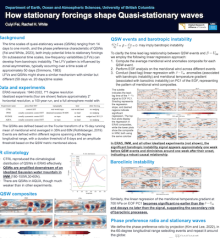How stationary forcings shape quasi-stationary waves
Cuiyi
Fei
University of British Columbia
Poster
The composite analysis of high-amplitude quasi-stationary Rossby wave (QSW), blockings, and low-frequency variability events reveals a distinct preference for meridional wind phase in both ERA5 and CESM2 simulations over Europe and North America. This phase preference is attributed to stationary forcings. To investigate the influence of stationary forcings, such as land-ocean contrast, topography, and zonal sea surface temperature (SST) asymmetry, seven 100-year simulations are conducted using CAM6 with prescribed SSTs. The focus is on understanding how these forcings impact quasi-stationary waves by employing a metric and variable amplitude thresholds. The analysis identifies the 50 strongest quasi-stationary wave events in each simulation, each lasting at least 8 days.
While the stationary forcings do not significantly alter the duration of these events, they have a strong influence on QSWs phase preference and amplitude. The extent of this impact varies considerably with the zonal asymmetries of the stationary forcing. Events are classified into positive and negative phases, aligned or opposite to the meridional wind composite mean, respectively, aiming at understanding QSW mechanisms with phase preference. Barotropic instability emerges as a unifying explanation for the occurrence and phase preference of QSWs, although the roots of such instability may extend beyond barotropic dynamics. Ongoing analysis will also understand the impacts of various stationary forcings.
While the stationary forcings do not significantly alter the duration of these events, they have a strong influence on QSWs phase preference and amplitude. The extent of this impact varies considerably with the zonal asymmetries of the stationary forcing. Events are classified into positive and negative phases, aligned or opposite to the meridional wind composite mean, respectively, aiming at understanding QSW mechanisms with phase preference. Barotropic instability emerges as a unifying explanation for the occurrence and phase preference of QSWs, although the roots of such instability may extend beyond barotropic dynamics. Ongoing analysis will also understand the impacts of various stationary forcings.

Poster file
Fei_Cuiyi_blocking_poster.pdf
(1.51 MB)
Meeting homepage
